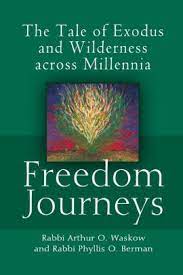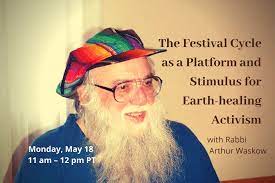
September, October, and November are traditional harvest celebration months in the Northern Hemisphere from variations on Octoberfests to those around the idea of Thanksgiving. The ancient Jewish harvest festival of Sukkot is celebrated from the full moon on September 20th to the September 27th this year, with the Autumnal Equinox occurring on the 22nd.
This week, we enjoy the second of two conversations on the sacred in the everyday and the sacred in the seasonal. We are joined from Philadelphia by Rabbi Arthur Waskow, co-founder of the The Shalom Center, which equips activists and spiritual leaders with awareness and skills needed to lead in shaping a transformed and transformative Judaism that can help create a world of peace, justice, healing for the earth, and respect for the interconnectedness of all life.
"I think if you live in the Temperate Zone (with its plant life) anywhere on earth, death and resurrection are a part of your spiritual life whether you call it that or not."
Rabbi Arthur Waskow
Rabbi Waskow is a lifelong social justice activist and the author of many books, including The Seasons of our Joy, which brings reverent renewal to the ancient agricultural and seasons-based celebrations of the Abrahamic religions, and his newest Dancing in God’s Eathquake, the coming Transformation of Religion.
You can follow Rabbi Waskow online at theshalomcenter.org
IF YOU LIKE THIS PROGAM,
you might also enjoy these Best of CP programs in our archive:
JOIN US again next week, when as we head into the autumn planting period for many regions, we‘re joined by a native plant steward and seedkeeper, Ernesto Alvarado. Known as Native Plant Guide on social media, Ernesto shares the love of California native plants through propagation, conservation, horticulture and that most important ingredient for good germination “a sprinkle of imagination.”
Cultivating Place is made possible in part by listeners like you and by generous support from the American Horticultural Society. Soon to Celebrate its 100th anniversary next year, AHS has been a trusted source of high quality gardening and horticultural information since 1922.
Today, AHS’s mission blends education, social responsibility, and environmental stewardship with the art and practice of horticulture. Members of AHS receive the award-winning flagship magazine, The American Gardener, free admission and other discounts to more than 345 public gardens with the Reciprocal Admissions Program, plus discounts on books, seeds, programs and more!
Listeners of Cultivating Place can receive a $10 discount on the annual individual membership of $35, by visiting www.ahsgardening.org/CP For your annual Membership to the American Horticultural Society for the special Cultivating Place rate of just $25 a year, head over to www.ahsgardening.org/CP.
Thinking out loud this week:
Hey It’s Jennifer –
Hey It’s Jennifer –
Ingathering – I like this word – its connotations of both harvest and pulling ourselves together - inward and yet still communal. Reflective and contemplative, but still gathering.
Which brings me to a story to share with you all from my travels – to Southern California this past weekend for a lovely day of history and garden conversation at the Chumash Indian Museum with photographer Caitlin Atkinson, with the museum folk including Garden Coordinator Brianna Rotella and Director Barbara Tejada, Dayle Bingham Visitor Servbices Coordinator, and finally with Hupa Elder and plantswoman Kat High. Kat’s home garden and plant work along with the ethnobotanical garden at the Museum are featured in Caitlin and my book, UnderWestern Skies. On the 7-hour drive down the I five Corredor, a long straight and often flat drive essentially bisecting California from North to South and on this stretch through the central valley of California. What was once a vast expanse of native grassland – dry in summer as now and damp in winter, is now a landscape layered with the history of settler mentality, overlaid with big agricultural, overlaid with water reality and seasonal as well as longer term drought leaving abandoned orchards over rows and rows of standing dead trees, and this interspersed by a now industrial transport mindset resulting in outposts of large distribution centers for Fed Ex and UPS and Amazon = behemoth lifeless concrete things. While the contours of the land is still visible – rolling golden hills to the west as you drive south and the craggier silhouette of the Sierra across the great valley to the east, the details tell a tragic tale to my eyes. As we drove we noticed that the roadsides were covered with Sacred Datura mounds of deep bluishgreen foliage spiked with bloom. The white trumpets making their presence known even from a distance and no doubt filling the air with fragrance each evening and then folding back into themselves by mid morning. A buzz with bees and hummingbirds and pollinating moths come nightfall when they are open in full. I mentioned the abundance of these white flowers – known as being poisonous it is also a powerful medicinal and culturally significant plant for Indigenous peoples of the American west, including the Chumash and Kat’s own people the Hupa. Kat turned to me and asked: you know why there are so many right now don’t you? And I thought for a moment, and I guessed “because they like disturbed land and the land is so very disturbed right now? And she said, Because the world needs more ceremony - they are trying to tell us that we need more ceremony.
More meaning making Through rituals and offerings and praise songs and gratitude. The kind of ceremony that is the source and foundation of our religious and seasonal rituals in sync with the natural world all around us. We need more ceremony.
What does that mean to me or you? We will all. Have our own answers of course, but our gardens and plant friends offer us the structure for incorporating the idea of ceremony and these sacred cycles every day turning to night, every cycle of the moon across the month, every cycle of the sun around the year across the seasons of our entire lives. Our gardens, our houseplants, our neighborhood trees and shrubs and parks and trails are sites of sacred exchange.
As you listen to this week's conversation with Rabbi Waskow, I know you know what I will revisit here – I am sure I don’t have to tell anyone who has been with me in these conversations for any amount of time at all.
My whole body listened and heard when Rabbi Waskow shared his story – his insight – his own burning bush story – the name of God – the saying of it is the echo of the very breath of life – which is the divine, the breath of God whoever God may be in your life. God and God’s breath animate our garden lives– in and out, in and out.
The azaleas in spring and the leaves of the trees and shrubs in autumn – are the blazing face of the divine. How much more ceremony do we need, if only we can see and acknowledge what is all around us?
I know I get a little out there sometimes, but then again – in these times when I am just stuck in here – in my own office in my own worries in my own anxiety and sadness and sometimes even despair – getting out there a little - connecting with the plant companions of my life reminds me of forces far bigger and better than me.
So be it.
WAYS TO SUPPORT CULTIVATING PLACE
SHARE the podcast with friends: If you enjoy these conversations about these things we love and which connect us, please share them forward with others. Thank you in advance!
RATE the podcast on iTunes: Or wherever you get your podcast feed: Please submit a ranking and a review of the program on Itunes! To do so follow this link: iTunes Review and Rate (once there, click View In Itunes and go to Ratings and Reviews)
DONATE: Cultivating Place is a listener-supported co-production of North State Public Radio. To make your listener contribution – please click the donate button below. Thank you in advance for your help making these valuable conversations grow.
Or, make checks payable to: Jennifer Jewell - Cultivating Place
and mail to: Cultivating Place
PO Box 37
Durham, CA 95938


















Comments